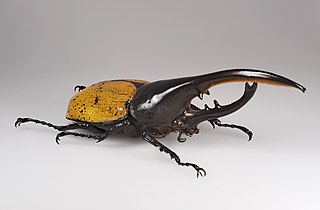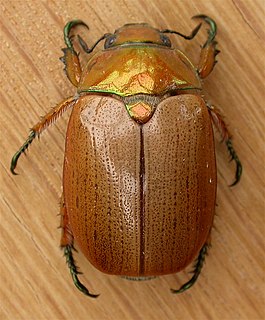
The Inca Empire, also known as the Incan Empire and the Inka Empire, was the largest empire in pre-Columbian America. The administrative, political and military center of the empire was in the city of Cusco. The Inca civilization arose from the Peruvian highlands sometime in the early 13th century. Its last stronghold was conquered by the Spanish in 1572.

The llama is a domesticated South American camelid, widely used as a meat and pack animal by Andean cultures since the Pre-Columbian era.

Coca is any of the four cultivated plants in the family Erythroxylaceae, native to western South America. Coca is known for its psychoactive alkaloid, cocaine.

The family Scarabaeidae, as currently defined, consists of over 30,000 species of beetles worldwide; they are often called scarabs or scarab beetles. The classification of this family has undergone significant change in recent years. Several subfamilies have been elevated to family rank, and some reduced to lower ranks. The subfamilies listed in this article are in accordance with those in Bouchard (2011).

Dung beetles are beetles that feed on feces. Some species of dung beetles can bury dung 250 times their own mass in one night.

The Inca tern is a tern in the family Laridae. It is the only member of the genus Larosterna.

Grimalditeuthis bonplandi is a squid named after the Grimaldi family, reigning house of Monaco. Prince Albert I of Monaco was an amateur teuthologist who pioneered the study of deep sea squids by collecting the 'precious regurgitations' of sperm whales. The specific name bonplandi refers to the French scientist Aimé Bonpland.

The Hercules beetle is a species of rhinoceros beetle native to the rainforests of Central America, South America, and the Lesser Antilles. It is the longest extant species of beetle in the world, and is also one of the largest flying insects in the world.

Dynastinae or rhinoceros beetles are a subfamily of the scarab beetle family (Scarabaeidae). Other common names – some for particular groups of rhinoceros beetles – include Hercules beetles, unicorn beetles or horn beetles. Over 1500 species and 225 genera of rhinoceros beetles are known.

The Inca dove or Mexican dove is a small New World dove. The species was first described by French surgeon and naturalist René Lesson in 1847. It reaches a length of 16.5–23 cm (6.5–9.1 in) and weighs 30–58 g (1.1–2.0 oz). The Inca dove has an average wingspan of 28.5 cm and a max wingspan of 32 cm. It is a slender species, with a gray-brown body covered in feathers that resemble a scaled pattern. The tail is long and square and edged with white feathers that may flare out in flight. The underwings are reddish, like other ground doves, and upon takeoff, the wings produce a distinctive, quiet rattling noise.

The scarab beetle subfamily Scarabaeinae consists of species collectively called true dung beetles. Most of the beetles of this subfamily feed exclusively on dung. However, some may feed on decomposing matter including carrion, decaying fruits and fungi. Dung beetles can be placed into three structural guilds based on their method of dung processing namely rollers, dwellers and tunnelers Dung removal and burial by dung beetles result in ecological benefits such as soil aeration and fertilization; improved nutrient cycling and uptake by plants, increase in Pasture quality, biological control of pest flies and intestinal parasites and secondary seed dispersal. Well-known members include the genera Scarabaeus and Sisyphus, and Phanaeus vindex.

The Trichiini are a tribe of the scarab beetle family (Scarabaeidae), though historically they were often classified as a subfamily, Trichiinae. The conspicuous bee beetles (Trichius) are probably the best-known genus in Europe.

Euphoria is a genus of scarab beetles in the subfamily Cetoniinae, the flower or fruit chafers. They are native to the Americas, where they are distributed from Canada to Argentina. They are most diverse in Mexico and Central America. As of 2012, there are 59 species in the genus.

The Oriental beetle is a species of shining leaf chafer in the family Scarabaeidae. It is a beetle about 0.7 - 1.1 cm long, with mottled, metallic brown- and black-colored elytra and a similarly-colored thorax and head during the adult stage. It is sometimes confused with the larger and more colorful Japanese beetle. During the larval stage, the Oriental beetle can be identified by the parallel line raster pattern.

The collared inca is a species of hummingbird found in humid Andean forests from western Venezuela, through Colombia and Ecuador, to Peru and Bolivia. It is very distinctive and unique in having a white chest-patch and white on the tail. Like other hummingbirds it takes energy from flower nectar, while the plant benefits from the symbiotic relationship by being pollinated. Its protein source is small arthropods such as insects. It is normally solitary and can be found at varying heights above the ground, often in the open.

Inca cuisine originated in pre-Columbian times within the Inca civilization from the 13th to the 16th century. The Inca civilization stretched across many regions, and so there was a great diversity of plants and animals used for food, many of which remain unknown outside Peru. The most important staples were various tubers, roots, and grains. Maize was of high prestige, but could not be grown as extensively as it was further north. The most common sources of meat were guinea pigs and llamas, and dried fish was common.

Dynastes satanas, the Satanas beetle, is a species of beetle belonging to the family Scarabaeidae; the name is sometimes misspelled as "satanus".

Inca clathratus is a species of flower chafer in the family Scarabaeidae, indigenous to Central and South America. These beetles can be seen surrounding the sap flows from injured or diseased trees anytime in the day and sometimes at night. They mostly feed at the sap flows of the trees, including avocado and mango trees. Like other beetles they also feed off of rotting fruit. There are a few different subspecies of Inca clathratus including: Inca clathratus sommeri, Inca clathratus clathratus, and Inca clathratus quesneli. The species name has been frequently misspelled as "clathrata" but the genus name Inca is masculine.

Inca is a genus of beetles belonging to the family Scarabaeidae.

Anoplognathus chloropyrus, commonly known as the brown- or golden-brown Christmas beetle, is a beetle of the family Scarabaeidae native to eastern Australia, being common in coastal Queensland, New South Wales and Victoria, the Great Dividing Range and the Murray-Darling river basin.




















